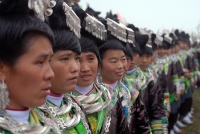

China
China
Capitale Beijing
Population 1.3 billion
Espérance de vie 73.47
L'accès à l'eau potable 88%
L'alphabétisation des adultes 90.9%
Mortalité des moins de 5 ans 20.25 per 1,000 live births
PIB par habitant $6,000

-
Fiche d'information du pays
 This Fact Sheet summarizes the key achievements of the Joint Programmes in China.
This Fact Sheet summarizes the key achievements of the Joint Programmes in China.
China Joint Programmes Fact Sheet.pdf (185 KB)
